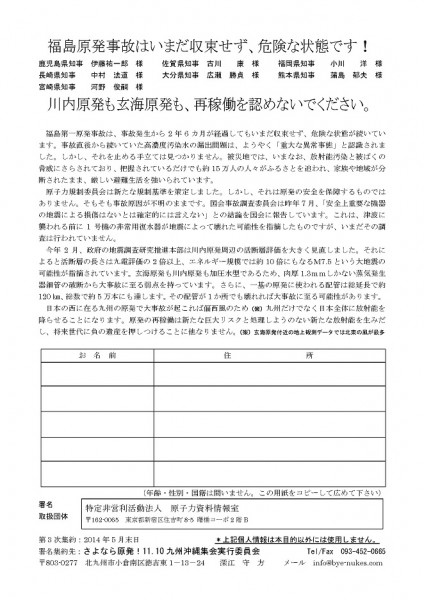【署名募集中(第3次集約:2014年5月31日まで)】 福島原発事故はいまだ収束せず、危険な状態です! 川内原発も玄海原発も、再稼働を認めないでください。
現在、九州の原発の再稼働を認めないよう九州各県知事に訴えるための署名を募集中(第三次集約 2014年5月末日)です。
是非みなさまのご協力をお願い致します。(6/11追記 ウェブ署名、1,205名もの方にご協力いただきました。誠にありがとうございました。)
● 署名用紙のダウンロード
● オンラインでの署名
:こちらから(日本語)
:Here(English)
(紙での署名がお済みであれば、オンラインで署名頂く必要はありません)。
福島原発事故はいまだ収束せず、危険な状態です!
川内原発も玄海原発も、再稼働を認めないでください。
鹿児島県知事 伊藤祐一郎 様
佐賀県知事 古川 康 様
福岡県知事 小川 洋 様
長崎県知事 中村 法道 様
大分県知事 広瀬 勝貞 様
熊本県知事 蒲島 郁夫 様
宮崎県知事 河野 俊嗣 様
 福島第一原発事故は、事故発生から2年6カ月が経過してもいまだ収束せず、危険な状態が続いています。事故直後から続いていた高濃度汚染水の漏出問題は、ようやく「重大な異常事態」と認識されました。しかし、それを止める手立ては見つかりません。被災地では、いまなお、放射能汚染と被ばくの脅威にさらされており、把握されているだけでも約15万人の人々がふるさとを追われ、家族や地域が分断されたまま、厳しい避難生活を強いられています。
福島第一原発事故は、事故発生から2年6カ月が経過してもいまだ収束せず、危険な状態が続いています。事故直後から続いていた高濃度汚染水の漏出問題は、ようやく「重大な異常事態」と認識されました。しかし、それを止める手立ては見つかりません。被災地では、いまなお、放射能汚染と被ばくの脅威にさらされており、把握されているだけでも約15万人の人々がふるさとを追われ、家族や地域が分断されたまま、厳しい避難生活を強いられています。
原子力規制委員会は新たな規制基準を策定しました。しかし、それは原発の安全を保障するものではありません。そもそも事故原因が不明のままです。国会事故調査委員会は昨年7月、「安全上重要な機器の地震による損傷はないとは確定的には言えない」との結論を国会に報告しています。これは、津波に襲われる前に1号機の非常用復水器が地震によって壊れた可能性を指摘したものですが、いまだその調査は行われていません。
今年2月、政府の地震調査研究推進本部は川内原発周辺の活断層評価を大きく見直しました。それによると活断層の長さは九電評価の2倍以上、エネルギー規模では約10倍にもなるM7.5という大地震の可能性が指摘されています。玄海原発も川内原発も加圧水型であるため、肉厚1.3mmしかない蒸気発生器細管の破断から大事故に至る弱点を持っています。さらに、一基の原発に使われる配管は総延長で約120㎞、総数で約5万本にも達します。その配管が1か所でも壊れれば大事故に至る可能性があります。
日本の西に在る九州の原発で大事故が起これば偏西風のため(※)九州だけでなく日本全体に放射能を降らせることになります。原発の再稼働は新たな巨大リスクと処理しようのない新たな放射能を生みだし、将来世代に負の遺産を押しつけることに他なりません。
署名取扱団体:特定非営利活動法人 原子力資料情報室 〒162-0065 東京都新宿区住吉町8-5 曙橋コーポ2階B
第3次集約:2014年5月末日
*上記個人情報は本目的以外には使用しません。
署名集約先:さよなら原発!11.10九州沖縄集会実行委員会 〒803-0277 北九州市小倉南区徳吉東1-13-24
メール info@bye-nukes.com(@は半角に直してください)
The Fukushima nuclear disaster is still not over and the disaster site is in a dangerous state!
Please do not permit the restart of the Sendai NPP or Genkai NPPs.
Yuichiro Ito, Governor of Kagoshima Prefecture
Yasushi Furukawa, Governor of Saga Prefecture
Hiroshi Ogawa, Governor of Fukuoka Prefecture
Houdou Nakamura, Governor of Nagasaki Prefecture
Katsusada Hirose, Governor of Oita Prefecture
Ikuo Kabashima, Governor of Kumamoto Prefecture
Shunji Kouno, Governor of Miyazaki Prefecture
After two-and-a-half years , the Fukushima Daiichi NPP disaster is still not resolved and the disaster site continues to be in a dangerous state. The problem of the highly radioactive water leakage that has continually occurred since immediately after the disaster has at last been recognized as being a “seriously abnormal state of affairs.” However, no means has yet been found to prevent this leakage. People in the disaster-stricken areas are still exposed to the threat of radioactive pollution and exposure. As far as is known, at least 150,000 people have been driven from the villages and towns where they used to live and are being forced to endure harsh living conditions as evacuees, their families and communities torn asunder.
Japan’s Nuclear Regulation Authority (NRA) has formulated new safety standards for NPPs. However, these do not guarantee NPP safety. In the first place, the causes of the nuclear disaster have not yet been clarified. In July of last year (2013), the National Diet of Japan Fukushima Nuclear Accident Independent Investigation Committee (NAIIC) concluded in its report to the Diet that “It cannot be stated with certainty that the earthquake caused no damage to crucial safety equipment.” This refers to the possibility that the emergency condenser of Unit 1 sustained damage from the earthquake prior to the tsunami striking the site, but this possibility has still not been properly investigated.
In February of this year, the government’s Headquarters for Earthquake Research carried out an overall review of the active fault assessment in the area surrounding the Sendai NPP. The review noted that the length of the active fault was more than twice as long as given in the Kyushu Electric Power Company’s assessment and that roughly than ten times the energy given in the assessment could be released, leading to the possibility of the occurrence of a huge M7.5 earthquake. Since both the Sendai and Genkai NPPs are pressure water reactors (PWRs), fractures of the steam generator tube walls, which are a mere 1.3 mm thick, is a weakness that could result in a severe accident. Moreover, roughly 50,000 pipes of a total length of around 120 km are built into each reactor. A severe accident could occur even if only one of these pipes is fractured.
Should an accident happen in the west of Japan, where Kyushu’s NPPs are located, the prevailing westerly winds* would ensure that not only Kyushu but the whole of Japan would be exposed to nuclear fallout. The restart of NPPs signifies the creation of a gigantic renewed risk and a further unresolvable radioactive disaster, and is tantamount to nothing less than the forcing of a grave negative heritage onto future generations.
* According to data from surface observational measurements, winds in the area surrounding Genkai NPP are mostly northeasterly.
Organization implementing the signature campaign: Citizens’ Nuclear Information Center (NPO)
B, 2F, Akebonobashi Co-op, 8-5 Sumiyoshi Cho, Shinjuku Ku, Tokyo, JAPAN 162-0065
Please deliver signature sheets to: Sayonara Genpatsu! 11.10 Kyushu/Okinawa Rally Executive Committee
1-13-24 Tokuyoshi Higashi, Minami Ku, Kokura, Kita Kyushu City, JAPAN 803-0277

